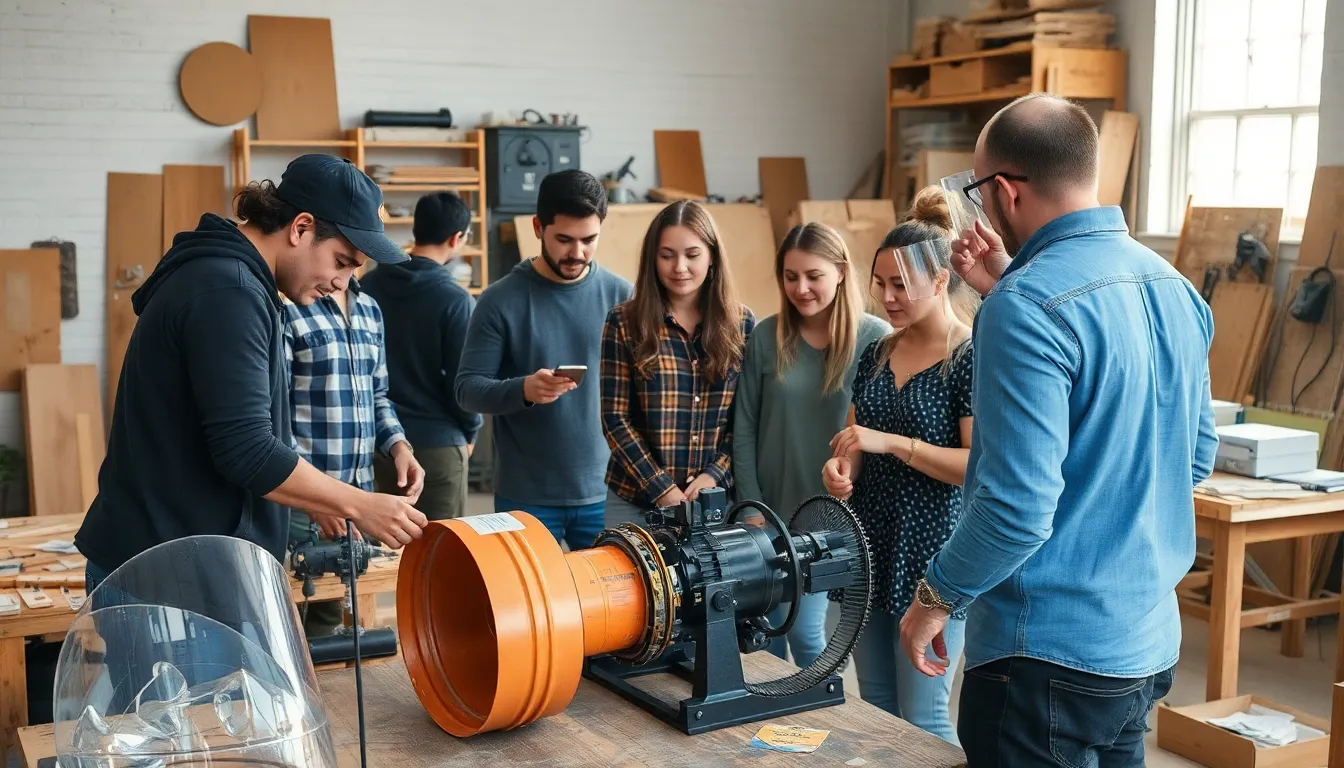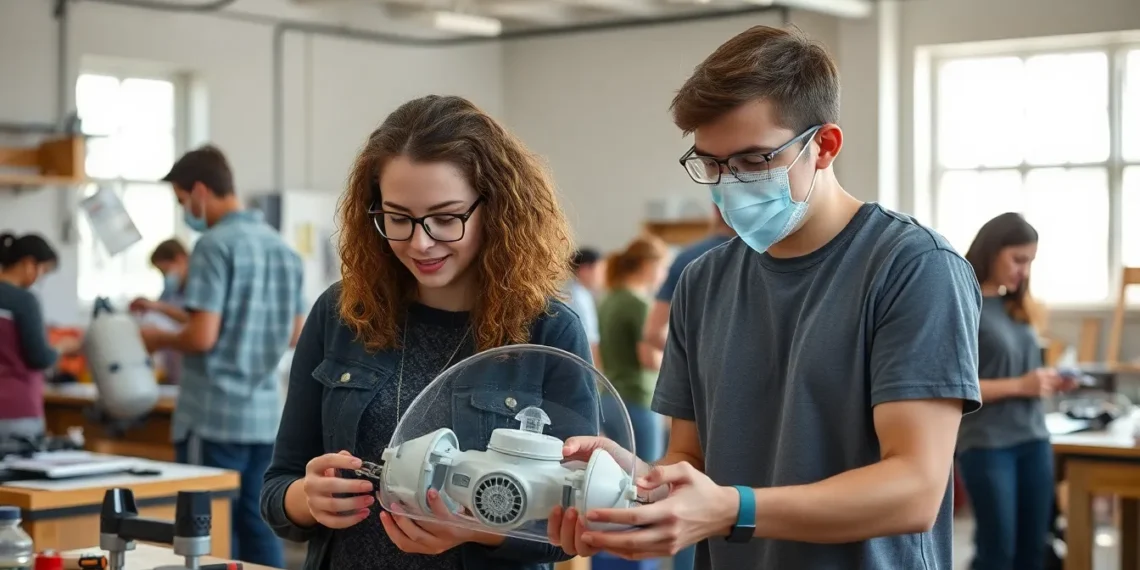In a world turned upside down by the pandemic, creativity found a way to shine through the chaos. Enter the COVID-19 Maker Challenge, where innovators and tinkerers unite to tackle the obstacles posed by the virus. This isn’t just another contest; it’s a call to arms for those who believe that necessity is the mother of invention—even if that necessity involves a mask and a six-foot rule.
Participants from all walks of life are rolling up their sleeves and getting crafty. From DIY ventilators to quirky social distancing gadgets, the challenge showcases the brilliance of human ingenuity. It’s a chance to turn frustration into fun while making a real difference. So, grab your glue gun and let’s dive into the world of inventive solutions that not only tackle COVID-19 but also bring a smile to our faces during these unprecedented times.
COVID-19 Maker Challenge
The COVID-19 Maker Challenge invites innovators to tackle problems caused by the pandemic. Participants produce practical solutions, such as DIY ventilators, face shields, and social distancing tools. Each project reflects the unique skills and creativity of the makers involved.
Community engagement plays a significant role in this initiative. Makers connect with each other, share ideas, and inspire one another to push the boundaries of innovation. Diverse backgrounds contribute to a rich variety of designs and solutions tailored to specific needs.
Previous challenges showcased advancements in medical device design and health safety products. Constantly evolving, the challenge adapts to emerging needs during the pandemic. Judges examine projects based on creativity, feasibility, and overall impact on public health.
Ultimately, the COVID-19 Maker Challenge fosters an environment where collaboration thrives. It empowers individuals to think critically and respond effectively to urgent issues. The initiative also highlights the importance of open-source design in accelerating response efforts.
Participating in this challenge cultivates a spirit of resilience and adaptability among creators. By addressing real-world problems, makers demonstrate how innovation can emerge even in crisis situations. The results serve not only to inspire further creations but also to provide valuable resources to healthcare providers and communities.
Objectives of the Challenge

The COVID-19 Maker Challenge aims to foster creativity while addressing pandemic-related issues. Participants create innovative solutions to enhance public safety and health.
Promoting Innovation
Innovation stands at the core of the challenge. Makers design various inventions like DIY ventilators and face shields. Each project highlights unique approaches to solving pressing problems. Participants leverage their skills to create effective solutions that resonate with the community’s needs. The judges evaluate ideas based on creativity and feasibility, encouraging makers to push the limits of their imaginations. Such a platform allows for the exchange of ideas and inspiration among professionals and amateurs alike, generating a collaborative atmosphere that fuels further innovations.
Supporting Communities
Community support plays a vital role in the challenge. Makers collaborate to share resources and knowledge, enhancing the collective response to COVID-19. Each project not only caters to immediate health needs but also empowers local groups through accessible, open-source designs. Efforts focus on providing tools and equipment that healthcare providers can utilize. By prioritizing community engagement, the challenge fosters networks where individuals can exchange insight and uplift one another. This sense of belonging reinforces resilience and emphasizes the importance of working together during crises.
Projects and Innovations
The COVID-19 Maker Challenge has led to remarkable projects that respond to urgent community needs. Participants showcase their skills and creativity through a variety of innovative solutions.
Notable Contributions
Innovators have created impressive contributions, including low-cost ventilators and 3D-printed face shields. Open-source plans allow individuals and organizations to replicate these designs, expanding their reach. DIY sanitizing stations and contactless tools emerged from this initiative, illustrating resourcefulness. Additionally, social distancing technology has been developed to help maintain safe interactions in public spaces. These endeavors reflect a collaborative spirit and commitment to addressing challenges posed by the pandemic.
Impact on Healthcare
Healthcare has significantly benefited from these innovations, especially in resource-limited settings. Access to essential medical supplies increased due to community-driven efforts. Projects like portable triage units streamline patient assessment in various environments. Makers also produced contact tracing apps, enhancing response efforts. The challenge promotes sustainability through local production, reducing supply chain dependency. Overall, these innovations have improved the efficacy of health responses while empowering communities to tackle public health issues.
Lessons Learned
Flexibility in response to unforeseen challenges emerged as a key lesson from the COVID-19 Maker Challenge. Innovators quickly adapted ideas, demonstrating that creativity thrives under pressure. Resource-sharing among participants emphasized the importance of community support, enabling makers to collaborate effectively.
Engagement with local needs became apparent through tailored solutions like low-cost ventilators and DIY face shields. Each project highlighted the significance of addressing immediate public health concerns. Judging criteria reinforced the necessity for creative and feasible designs that create lasting impact on health and safety.
Sustainability through local production formed a vital lesson learned. This approach reduced dependency on long supply chains while empowering communities to take charge of public health solutions. Connections between makers fostered resilience and showcased the strength of collaborative systems.
Knowledge dissemination proved crucial during the challenge. Open-source designs ensured that innovations remained accessible to a wider audience, promoting widespread utilization of solutions. Sharing resources not only advanced projects but also strengthened the maker community.
Expectations surrounding innovation transformed throughout the challenge. The emphasis shifted towards integrating technology into practical applications, such as portable triage units and contact tracing apps. Participants demonstrated that with imagination and teamwork, significant impacts on healthcare could be achieved.
Insights gained extend beyond immediate project outcomes. The challenge highlighted pathways for future collaborations, showcasing the potential for continuous improvement in public health responses. Emphasizing community engagement and creativity paved the way for long-term strategies in addressing global health crises.
Future of Maker Challenges
Maker challenges continue to evolve, fostering innovation and community engagement. Future initiatives may emphasize collaborative projects, allowing participants to pool resources and expertise. Increased focus on sustainability ensures that solutions remain impactful while reducing environmental footprints.
Emerging technologies, such as artificial intelligence and advanced manufacturing, could further enhance the creative process. Greater accessibility to digital tools means more individuals can participate, cultivating a diverse range of ideas.
Participation may involve partnerships with educational institutions and industries, expanding the impact of maker challenges. Enhanced support networks will provide guidance and mentorship, enabling makers to navigate complex project developments. Increased visibility of projects through online platforms amplifies their reach, showcasing solutions to a global audience.
Specific trends, like health-focused innovations, will likely continue to flourish in response to ongoing public health challenges. Data from past challenges suggests that addressing local needs will drive future designs.
EYemphasis on open-source strategies promotes widespread adoption, ensuring that successful innovations can benefit communities beyond the initial creators. In conclusion, the future of maker challenges depends on collaboration, innovation, and an unwavering commitment to addressing pressing societal issues.
Conclusion
The COVID-19 Maker Challenge has proven to be a powerful catalyst for innovation and community resilience. By harnessing creativity and collaboration, participants have developed practical solutions that address urgent health needs. The emphasis on open-source designs and local production not only enhances accessibility but also empowers communities to take charge of their health responses.
As the landscape of maker challenges continues to evolve, the lessons learned here will guide future initiatives. Embracing sustainability and fostering partnerships will be essential in creating impactful solutions. With a strong focus on community engagement and resource-sharing, the potential for innovation remains limitless. The spirit of collaboration ignited by this challenge will undoubtedly inspire future makers to tackle pressing societal issues head-on.















